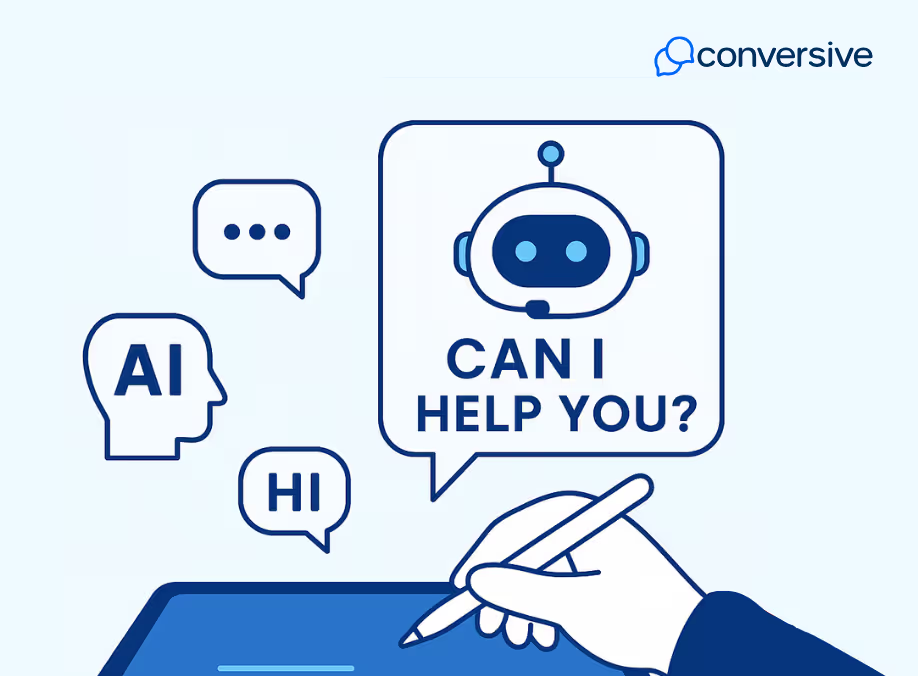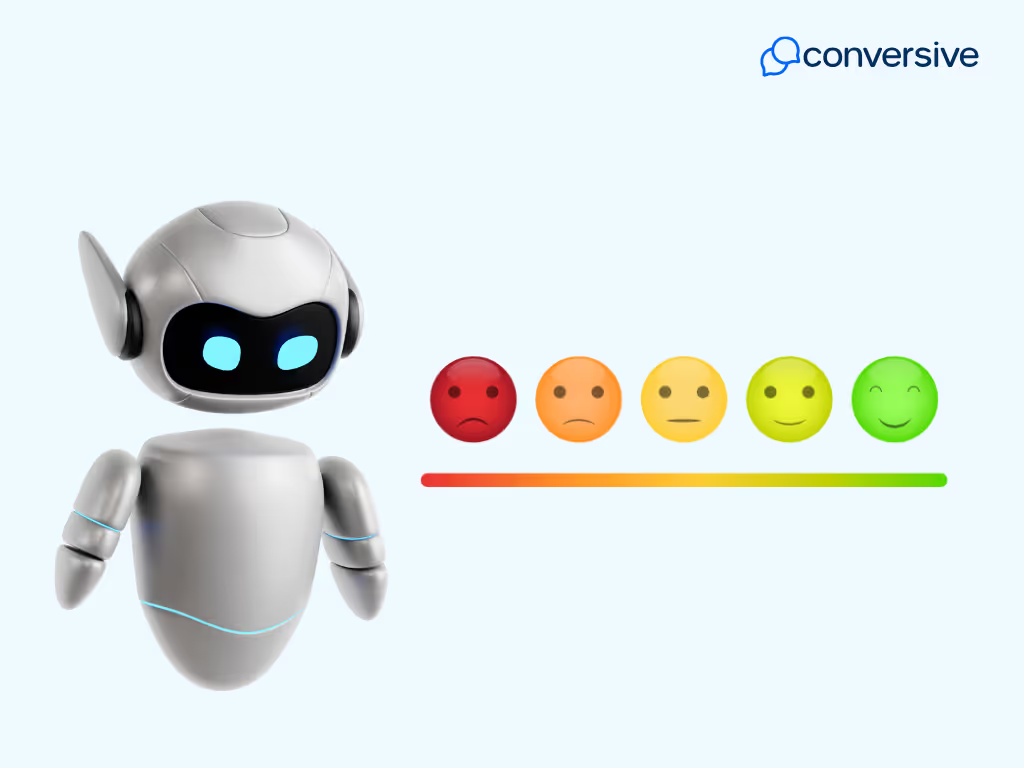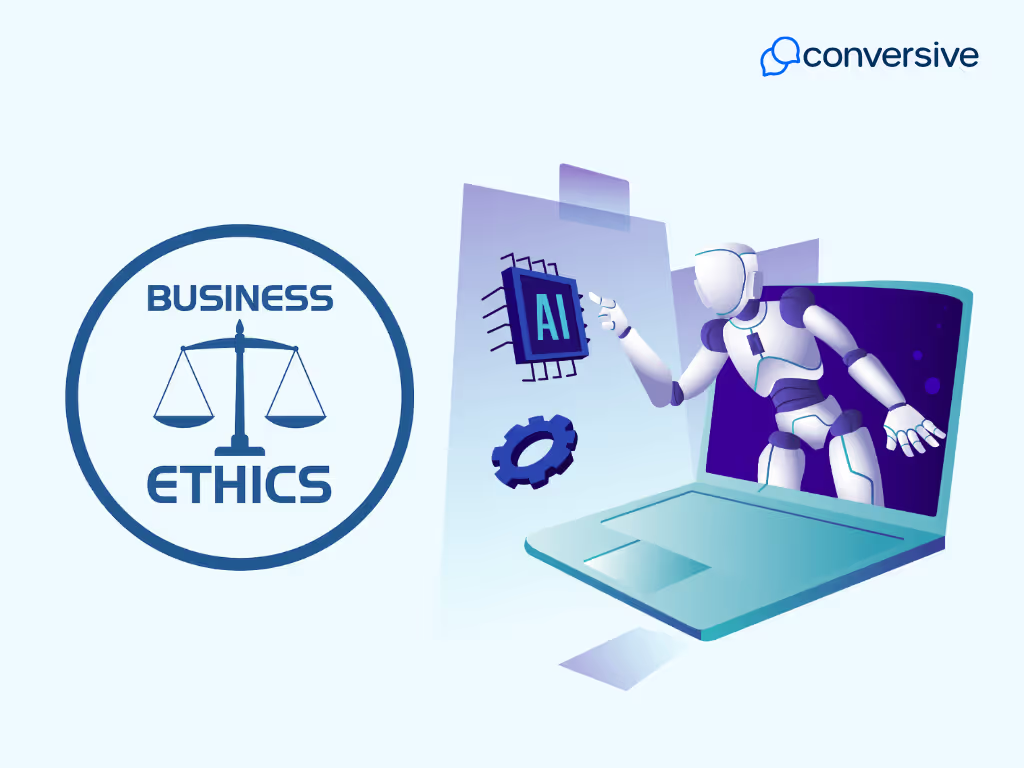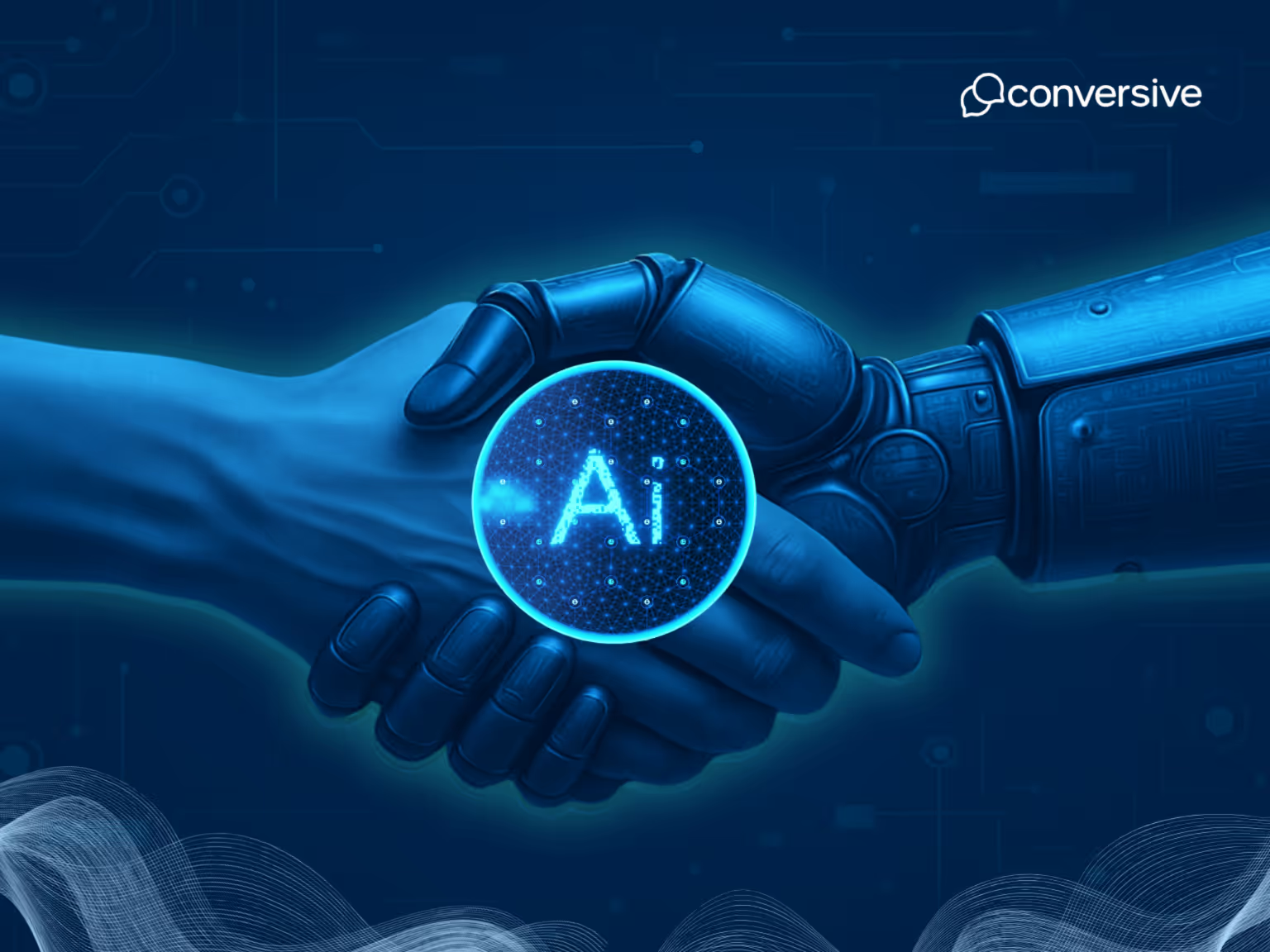
Why Does Your CX Strategy Need AI Now More Than Ever?
AI is transforming customer experience by delivering faster, more personalized, and scalable support. Discover how businesses use AI to predict needs, reduce churn, and create seamless, always-on customer journeys.
Let’s face it, customers today want things faster and more tailored to them. They expect companies to know what they need even before they ask and to respond instantly. Because of this, using AI isn't just a nice bonus anymore, rather it's a necessity!
For instance, an online clothing store tracks a customer's previous purchases and browsing habits. When the customer logs in, the website instantly shows personalized outfit suggestions, offers a chat with an AI assistant for quick size or style questions, and predicts future preferences to suggest new items before the customer even searches for them.
In this playbook, I’ll walk you through why AI in Customer Experience (CX) is one of the most potent competitive weapons of the digital age, backed by real-world case studies, stats, and actionable strategies. So, let’s get started with our first obvious question, Why are AI and CX now inseparable?
Why AI and CX Are Now Inseparable
Customer experience, or CX, used to mean just being friendly and having easy, hassle-free service. Now, it’s mainly about using digital tools, offering many ways for customers to interact (like websites, webchats, apps, social media), and making decisions based on lots of data. Artificial intelligence (AI) is the key technology behind this shift, helping companies understand and improve how they connect with customers across all channels.
Whenever you see movie suggestions on Netflix that are tailored just for you, get updated about flight delays as they happen, or chat with a customer service bot to solve a problem, you're using services that rely on AI technology to improve your experience, in fact, you’re experiencing the frontlines of AI-powered CX.
According to Pylon's comprehensive case study, AI-powered customer support reduces response times by 97%. Master of Code Global reports, 46% of financial institutions employing AI have reported improvements in customer experience, with 79.5% planning to increase investments in AI-driven customer experience technologies.

Benefits of AI in Customer Experience
AI helps improve how companies interact with customers. It can customize their experience based on data, handle simple tasks automatically, and be available at all times. This makes customers happier, more likely to stay loyal, and helps the business do better.
Below is a more detailed look at the benefits:
1. Personalization at Scale
Let’s be honest, traditional ways of dividing customers into broad groups like “millennials” or “frequent shoppers” are no longer effective. Customers now expect brands to understand them personally, not just categorize them broadly.
With AI in the toolkit, companies can process a lot of data instantly and learn from customer behaviors. This means they don’t just create general groups anymore but can tailor experiences or offers directly to each individual at any moment.
This also means, no more fixed segments, AI can create “dynamic personas” that can change based on what the customer is doing right now. For example, it looks at recent activity, mood, location, and preferred ways of communicating to figure out what the customer needs at that moment.
A good example is Netflix. Instead of just recommending shows based on what genres you like, their AI considers how long you watch, where you pause or stop, what device you're using, and even which images for shows catch your eye. This allows Netflix to give each person a highly personalized viewing experience in real time.
Strategic Takeaway
Brands that personalize merely by name or basic demographics are falling behind. With AI, personalization becomes:
- Contextual: What does the customer want in this moment?
- Predictive: What will they likely need next?
- Conversational: How do they prefer to be engaged?
Pro Tip: If you're building or auditing your CX personalization stack, ask:
- Are your recommendations reactive, or predictive?
- Are you segmenting customers by who they are, or what they do and feel?
2. Always-On Availability
Customer patience is shrinking, and we are already experiencing that. No one wants to wait for hours, or even minutes. Customers expect immediate, accurate, and helpful responses whenever they reach out, no matter the time or channel.
With the advancements in natural language processing and machine learning, AI can now chat with people in a way that feels quite natural. These virtual helpers aren't just answering simple questions, they can walk you through complicated tasks, suggest things tailored to you, and pass your problem on to a real person if it’s too tricky for them.
And this isn’t a passing trend. By 2027, chatbots will become the primary customer service channel for roughly a quarter of organizations, according to Gartner, Inc.
AI never sleep or take breaks, so they can always be working. They help keep the way a company communicates consistently, solve customer problems quicker, and decide which issues to focus on first. Plus, they learn from every interaction to get better over time.
For example, Amtrak’s AI helper, Julie, handles over 5 million customer requests each year. It saves money on customer service and makes customers happier. Julie doesn’t just answer questions, she also helps book tickets, fix problems, and make sure customers get what they want fast.
Strategic Takeaway
Brands that only offer limited-hour support are increasingly out of sync with modern customer expectations. With AI, support evolves into:
- Proactive: Can we predict and solve problems before the customer reaches out?
- Scalable: Can we handle 10x the traffic without adding headcount?
- Consistent: Can we deliver the same experience at 3 AM as we do at 3 PM?
Pro Tip: If you're evaluating or upgrading your customer service strategy, ask:
- Are your support channels reactive or proactive?
- Can your virtual agents handle more than just basic queries?
- Is your customer data feeding into your support systems to improve responses over time?
3. Speed and Efficiency
Today, speed equals satisfaction, which means, people want things quickly and get annoyed when they have to wait or deal with complicated processes. It also hurts businesses because unhappy customers can lead to lost sales. Using AI helps fix these problems by making everything run more smoothly and efficiently.
At the heart of this transformation is Natural Language Processing (NLP). Instead of just reading what someone says, NLP enables figuring out what the person really wants or needs. For example, they can quickly sort customer complaints, figure out which ones are urgent, and send them to the right person, or even fix the problem automatically.
Vodafone uses an AI helper named TOBi that manages 45 million monthly calls and resolves 70% of digital inquiries independently. It cuts call times by over a minute and boosts customer satisfaction scores.
Strategic Takeaway
Brands that rely solely on human speed are hitting a ceiling. AI breaks through that limit by making operations:
- Instant: Are we reducing wait times to seconds, not minutes or hours?
- Smart: Are we solving problems with context, not just scripts?
- Effortless: Are both customers and agents spending less time per interaction?
Pro Tip: If you’re looking to boost operational performance, ask:
- Are your processes built for scale, or just staffed for it?
- Can your systems prioritize based on intent and urgency?
- Where are the manual handoffs that AI could eliminate?
4. Deeper Customer Insights
You might have a lot of information about your customers, like emails, chat messages, reviews, and phone calls, but you don’t always know how to use it effectively. AI can help by sorting through all that messy data and finding useful patterns. This means you understand not just what has happened, but also why it happened and what might happen next, helping them make better decisions.
AI-powered tools like sentiment analysis, customer journey analytics, and predictive modeling work in real-time, pulling signals from every interaction to create a true 360° view of each customer. Instead of relying on periodic surveys or outdated dashboards, companies can now get a live pulse on how customers feel and what they need.
Alorica, for example, helped a sportswear brand cut customer escalations by 75% using detailed analysis, and they improved a client’s efficiency by 20% with their specialized AI platform.
Strategic Takeaway
Brands that rely on lagging indicators or gut instinct are missing the full picture. With AI, insights become:
- Real-Time: Are we learning from customers as they interact, not after they leave?
- Holistic: Are we connecting dots across channels and touchpoints?
- Predictive: Are we identifying future needs or risks before they happen?
Pro Tip: If you're upgrading your analytics strategy, ask:
- Do you know how your customers feel, not just what they do?
- Can you pinpoint friction points across the entire journey?
- Are your teams acting on insights, or just reporting them?
5. Reduced Churn and Increased Loyalty
Keeping customers happy and sticking around is just as important as getting new ones. The tricky part is figuring out when someone is about to leave and what to do about it. That's where AI helps by looking at how customers behave and predicting who might be about to churn, or leave.
AI finds signs like less interest, negative comments, or changes in what they buy. When it spots these signs early, companies can send special offers or reach out personally to try to keep the customer. This helps them act before someone actually leaves.
According to IBM, predictive analytics can predict customer churn with up to 90% accuracy, enabling proactive retention strategies. AI also learns over time what makes each customer happy, their favorite rewards, exclusive content, or the best way to communicate, so brands can build stronger, lasting relationships.
Strategic Takeaway
Brands that wait for customers to leave before reacting risk losing them forever. With AI, retention becomes:
- Predictive: Can we identify churn signals before customers disengage?
- Personalized: Are our retention efforts tailored to individual needs and preferences?
- Timely: Do we act immediately to re-engage at-risk customers?
Pro Tip: When building your retention strategy, ask:
- How accurately can you predict who might leave, and why?
- Are your offers and outreach personalized and relevant?
- Is your team equipped to act on AI’s insights in real-time?

How Is AI Reshaping the Frontline of Customer Service?
Let’s clear the air, AI isn’t here to take over the contact center. It’s here to make human agents faster, smarter, and more effective.
The future of customer experience is not human vs. machine, rather, it’s human + machine. And the best brands are already embracing this hybrid model.
Conversational AI is the New First Responder
AI-powered tools like chatbots, voice assistants, and automated phone systems now handle most basic customer questions, like checking an order, resetting a password, or asking about bills. This lets human workers concentrate on more complicated or sensitive issues that need understanding and care.
Forbes Advisor reports that 64% of business owners believe AI has the potential to improve customer relationships, indicating a positive outlook on the role of AI in enhancing client interactions. This change makes customer support faster and more efficient, while also helping human agents avoid getting overwhelmed and exhausted by boring or repetitive tasks.
AI Co-Pilots for Human Agents
AI is changing how the people working in support or customer service do their jobs. It’s like having a really intelligent helper beside them. During chats or calls, AI can suggest what to say next, notice how the customer feels, and quickly find helpful articles or solutions.
For example, DevRev’s AI assistant helps support workers respond faster, about 40% quicker, by sorting issues automatically and showing answers before agents even ask for them. Overall, this makes solving problems quicker and helps support teams do better work more confidently.
This kind of augmentation not only speeds up resolution time, it also boosts confidence and performance across the entire support team.
How AI Tools are Powering Customer Success in Different Industries?
The AI-powered CX stack has evolved rapidly. It's not just doing routine jobs anymore but also helping companies plan and make better decisions. Here are the main features and how different types of businesses are using them:
1) Predictive Insights: Forecast Customer Behavior Before It Happens
AI uses customer data and behavioral signals to predict satisfaction, churn, and future needs, thus, enabling proactive CX strategies.
Use Cases:
- Financial Services: Predict which clients are likely to close accounts or miss payments, allowing advisors to intervene early.
- Legal: Identify clients who are disengaging or less responsive, prompting proactive check-ins before losing them.
- HR/Staffing: Forecast candidate drop-off or placement success based on resume behavior, engagement with recruiters, or interview feedback.
- Education: Spot students at risk of dropping out by analyzing participation, grades, and help-desk queries.
2) Automated Ticket Triage: Smarter Routing, Faster Resolution
AI analyzes support requests in real-time and routes them to the right team or agent based on complexity, tone, and priority.
Use Cases:
- Real Estate: Prioritize emergency maintenance requests (e.g., water leaks) over general queries.
- HR/Staffing: Route urgent candidate questions (e.g., offer letters, onboarding) to the right recruiter instantly.
- Education: Direct financial aid, admissions, and tech support tickets to their respective departments.
- Healthcare & Wellness: Escalate health-related queries while routing admin questions (like billing) to support teams.
3) Hyper-Personalized Engagement: Tailoring Every Touchpoint
AI delivers context-aware, individualized experiences, from emails and offers to chat and in-app messaging.
Use Cases:
- Financial Services: Serve tailored investment advice based on transaction history and life stage.
- Real Estate: Recommend properties based on browsing history, budget, and neighborhood preferences.
- Legal: Provide resources or service options aligned with case type, client history, and urgency.
- Healthcare & Wellness: Suggest relevant wellness programs, reminders, or telehealth services based on patient behavior and history.
4) Conversational AI Assistants: Always-On, Always-Learning Support
AI-powered chatbots and voice assistants provide instant, 24/7 support, growing smarter with every interaction.
Use Cases:
- Financial Services: Chatbots that answer balance, transaction, and loan status queries.
- Real Estate: Virtual agents schedule property visits, answer FAQs, and share listings.
- Legal: AI assistants offer legal intake services, gather initial case info, or explain service tiers.
- HR/Staffing: Virtual recruiters screen candidates, answer job-related questions, and guide through application steps.
- Education: Chatbots provide answers on admissions, deadlines, and class schedules.
- Healthcare & Wellness: Virtual health assistants offer symptom checks, appointment scheduling, and follow-up reminders.
5) Voice & Conversation Intelligence: Turning Calls into Gold
AI listens to and analyzes calls in real time, detecting sentiment, keywords, and compliance gaps to improve quality and coaching.
Use Cases:
- Financial Services: Flag compliance issues or detect customer frustration during service calls.
- Real Estate: Identify buyer hesitation or interest during property discussions.
- HR/Staffing: Analyze recruiter-candidate conversations to improve hiring pitches and reduce drop-offs.
- Education: Review counseling calls for trends in student concerns or satisfaction.
- Healthcare & Wellness: Ensure empathy and accuracy in patient interactions, helping staff improve bedside manner even over the phone.
6) Multichannel Consistency: Unified Experiences Across Platforms
AI ensures customers get consistent, personalized service across chat, email, phone, and social, without repeating themselves.
Use Cases:
- Financial Services: Clients can switch from chatbot to human agent without losing context.
- Real Estate: A prospect engaging on Instagram can seamlessly continue the conversation on email or WhatsApp.
- Legal: Clients get case updates via their preferred channel (SMS, email, portal) with unified messaging.
- HR/Staffing: Candidates can engage over LinkedIn, email, or chatbot, with complete continuity.
- Healthcare & Wellness: Patients can confirm appointments via SMS and get reminders via email, all synced to the same system.
Pro Tip: When evaluating smart CX tools, prioritize those with native integrations to your CRM, NPS platform, and product analytics. Seamless data flow is critical to making AI insights actionable in real time.

Challenges and Ethical Considerations of Using AI in CX
Let’s not pretend AI is perfect. While it offers tremendous potential, it also introduces real risks that businesses must navigate responsibly. Here's what to watch out for:
1. Bias & Fairness: When Algorithms Inherit Inequality
AI systems are only as good as the data they're trained on. If historical data reflects biases, based on race, gender, income, or geography, the models will likely replicate or even amplify them.
Examples:
- In financial services, AI might unfairly flag loan applicants from certain ZIP codes as high-risk due to historical redlining.
- In HR/staffing, recruitment algorithms trained on past hiring patterns might prioritize candidates from similar educational or demographic backgrounds, unintentionally discriminating.
What to do: Regularly audit models for disparate outcomes. Include diverse data sets and stakeholders in model training and validation.
2. Privacy Concerns: Walking the Line Between Insight and Intrusion
AI often relies on large-scale data collection, from behavioral tracking to voice transcripts. If not handled transparently, this can damage trust and run afoul of regulations.
Examples:
- A real estate chatbot collecting tenant conversations for optimization might raise flags if privacy policies aren't clearly disclosed.
- In healthcare, predictive tools using patient data must meet stringent HIPAA or GDPR compliance standards.
What to do: Implement data minimization, strong consent protocols, and secure handling practices. Always tell customers how their data is being used.
3. Over-Automation: Don’t Replace the Human Touch
AI improves speed and scale, but it can't fully replicate empathy, judgment, or nuanced conversation, especially in sensitive situations.
Examples:
- In legal services, fully automated intake might miss context that's crucial for case understanding.
- In healthcare, AI triage must know when to hand off to a clinician, lives may depend on it.
What to do: Design AI to augment, not replace, human teams. Offer easy handoff to live agents and empower staff to override automation when necessary.
Pro Tip: Lead With Ethics by Design
Compliance is non-negotiable, but ethical AI goes beyond the legal minimum. Frameworks like those from the OECD, AI Now Institute, and IEEE advocate for:
- Transparency: Explain how decisions are made.
- Accountability: Be able to trace outcomes back to decisions or data sources.
- Inclusiveness: Ensure systems work fairly for all segments of your customer base.
How Conversive Improves AI-Driven Customer Experience
Conversive brings AI-powered customer experience to life by combining real-time engagement, and CRM intelligence into a single, unified messaging platform. It enables organizations to deliver faster, more relevant, and highly personalized interactions at scale, while maintaining full regulatory compliance.
Here’s how Conversive directly supports the core benefits of AI in CX:
I) Personalization with CRM Context
Conversive leverages real-time CRM data to personalize every conversation based on customer behavior, history, and preferences. This ensures that interactions are not just targeted, they’re meaningful.
II) Instant, Consistent Responses Across Channels
AI-powered workflows automate responses to high-intent actions such as inquiry submissions, appointment bookings, or policy updates. Whether it’s SMS, WhatsApp, or Facebook Messenger, responses are triggered instantly and routed intelligently.
III) Unified Conversation History
Every message is logged against the appropriate record in the CRM. This creates a continuous, cross-channel thread that improves team coordination and ensures no context is lost, even when conversations are handed off between departments.
IV) Scalable Automation With Escalation Options
Conversive handles common tasks like reminders, FAQs, and follow-ups. When a situation requires a human touch, it enables seamless handoff to a live agent, thus, preserving context and continuity.
V) Enterprise-Grade Compliance
Built-in support for TCPA, HIPAA, and GDPR means customer interactions remain secure, permission-based, and audit-ready, especially important in industries like healthcare, education, and finance.
Let’s explore how we can help you deliver smarter, more connected experiences, book a demo, today!
Frequently Asked Questions
1. Why is AI important for customer experience today?
AI helps brands deliver faster, more personalized, and consistent interactions, turning CX into a key competitive advantage.
2. How is AI personalization better than traditional segmentation?
AI creates real-time, behavior-based personas, going beyond fixed groups like age or location for deeper personalization.
3. Can AI help reduce customer churn?
Yes. AI spots early signs of disengagement and triggers timely, tailored actions to retain at-risk customers.
4. Will AI replace human customer service agents?
No. AI supports agents by handling routine tasks, so humans can focus on complex, high-value conversations.
5. Is AI only for large companies?
Not anymore. Scalable, no-code tools make AI accessible and effective for businesses of all sizes.
6. What are the risks of using AI in CX?
Bias, privacy issues, and over-automation are key concerns. Responsible design and human oversight are essential.
7. How soon can we see ROI from AI tools?
Many teams see improvements in speed and satisfaction within weeks, especially with the right use cases.
8. What tools should we use to start with AI in CX?
Look for platforms with chat automation, predictive insights, CRM integration, like Conversive for unified, intelligent CX.



.png)

